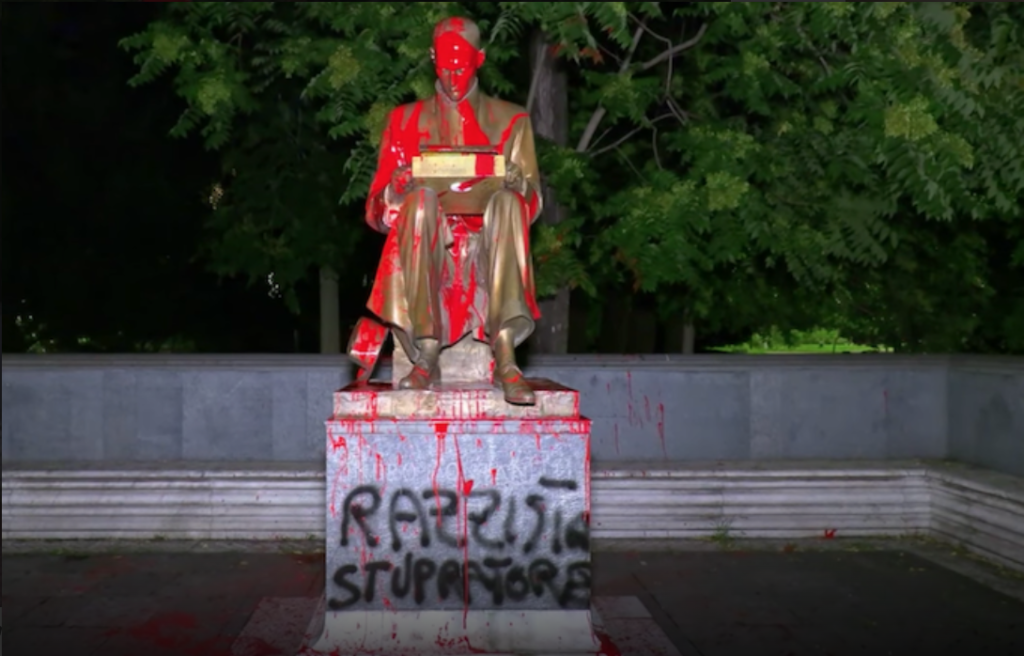FORECASTED ART CRIME!
by Roberto Concas
ICONOCLASH
Let’s Shoot and Smear Sculptures!!!
In Milan, the sculpture in memory of Indro Montanelli has been smeared with red paint and outrageous writing!
The “crime” was in the air, and after the episodes of the American uprising, the risk, said in the slang of the police forces, had been “attentive” for some days, but above all it had been widely announced and almost “suggested”, as the pages of the most important newspapers show.
Free, thinking astorists and easy prophets, for insignificant executors of a useless misdeed!
ICONOCLASH
This is not “Iconoclasm” in the Byzantine sense, nor is it an iconoclastic action of literary translation seen as: destruction of images.
It is not a form of “theoclastic” struggle, because faith and religion do not seem to appear, just as it is not the kit of a post-war “Liberation”, or a “Lutheran reform” or a “French Revolution”.
It could perhaps be an “Iconoclash” as theorized by the French philosopher and anthropologist Bruno Latour, a neologism to consider images as a “battleground“.
Sculptures, like all works of art in general, for Latour, are able to “unleash passions” that lead to acts of violence and the destruction of images assumed as a unifying symbol of “another thinking”!
In the fight against these symbols, the reasoning that is elaborated, by the group with “unleashed passions”, seems never to be too deepened or elaborated, but mostly semantically moved by a few directions of action and objectives to be achieved in a short time and with resounding results.

PICTOGRAPHIC SYMBOLS
It is significant that the expressive language used for these acts of vandalism is the same, borrowed and mutant, of the emoji and the messages, in practice we reason and dialogue by pictographic symbols!
In fact, such sculptures are shown iconographically and iconologically as the upside down ones, posted on social media and flanked by likes and other signs of approval or contempt.
The group of “demolitionists” and “smearers” has updated its language in tradition, made of slogans rather than thought processing, to touch the buttons of discontent, such as those of respectability, dogmatic and denialist historicism, ideological and instrumental, to move on to the echoes of “revolutions” and social rebellion finding in the monumental sculptures the target, the target closest to them, in practice the one around the corner, two blocks in the first square to the south.
It is in this way that in Richmond, Virginia, the “fury” falls on the monumental sculpture of Christopher Columbus, as an “iconic” representation that becomes the immediate battleground for an “Iconoclash” action.
Besides, it would be to say that perhaps, Christopher Columbus, like the other characters immortalized, would not even have liked to be represented in that way, but these are the rules of the “artistic” representation with the commemorative sculptures, realized in periods far from the facts and “loaded”, often and heavily, of other values by now “exhausted”.
ART AND THOUGHT
But this is the natural, continuous and irrepressible stratification of history represented by art as one of the instruments of representation of philosophical thought of the time, as were public works, music, armies.
Fighting against the instruments of representation, like art, is a battle lost at the start, the sculpture overturned and thrown in water or soiled, will be collected, cleaned, restored and taken to a museum that will keep it, as its duty dictates, waiting to be able to relocate, in some time and calm the waters, even after many decades, in the original square or in the nearest one, loading it with other meanings added.
ART?
From the point of view of Art, the one with a capital A, it could be said that many of these commemorative sculptures are not real works of art, they are sculptures, sometimes simply monumental, valuable, the work of excellent artists or craftsmen-artists, harnessed in the representation of the feelings of individual interest groups.
These sculptures, which do not usually reflect collective thought, as works of art do more often, stand at the crossroads between the celebratory and representative functions of a community, those of social and political mediation, those of furnishing and urban qualification.
If the many implications that derive from these reckless and useless gestures did not exist, moving abstractly into a purely theoretical analysis and contemporary art criticism, we could also give a symbolic/aesthetic and even artistic value to some of these “gestures of protest”; the example is referable to the news image showing Columbus’ forehead pierced by a “tomahawk”, the Native American axe.
INSERT IMAGE OF CHRISTOPHER PIGEON
One could say that in this intervention, of “vandalizing” the monument, Banksy docet!
IDEOLOGY
However, these gestures remain and will always remain intolerable in their action of denial of history and in their language proper to a dictatorial totalitarianism, they will be gestures that will be reabsorbed in normality, encased, overcome by other interpretative and even artistic needs.
Rather, more serious could be considered the ideological actions of those who, in these forms of neo-language and short and simplified thinking in social networks, feeling protected by short-sighted profiles of monocular historical reconstruction, loudly call for the removal of other sculptures, accusing the portrayed historical figures of every vileness, artifactually forgetting the historical condition and that of historicization widely occurred and revised.
These emblematic sculptures, almost always revisited in their meaning and significance, brought back to “decoration” with some slim and forgotten symbolic implications, democratically accepted between the parties, even with opposing values, in any case, remain a wrong target.
Finally, and where companies just don’t want these sculptures anymore, it could become a useful opportunity to start a new collection!





